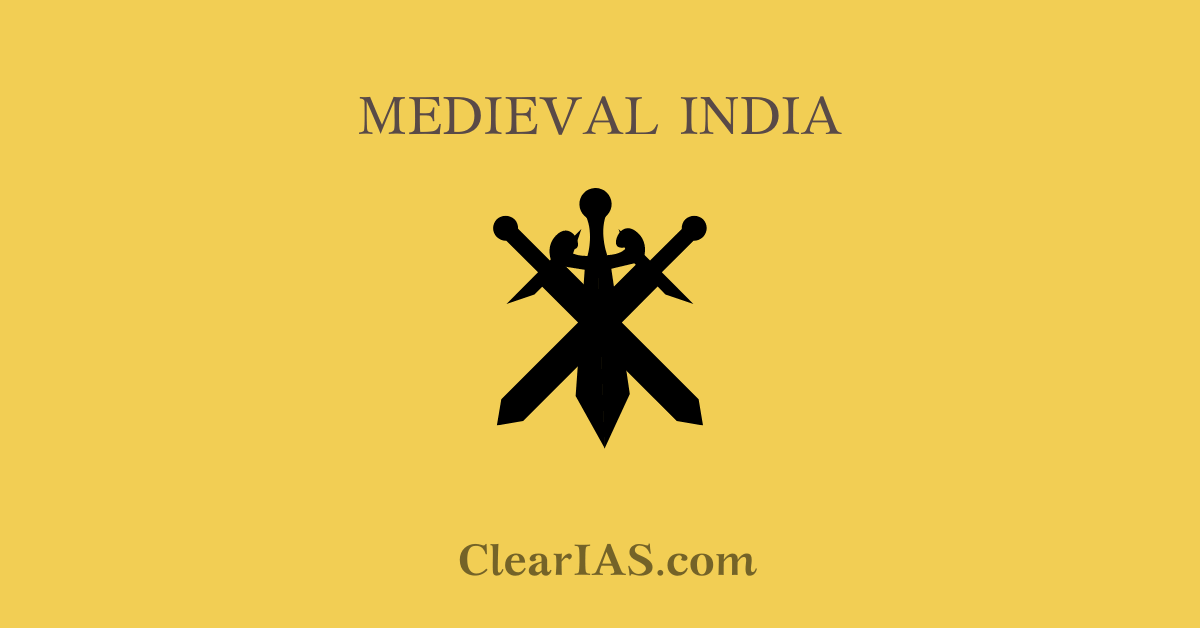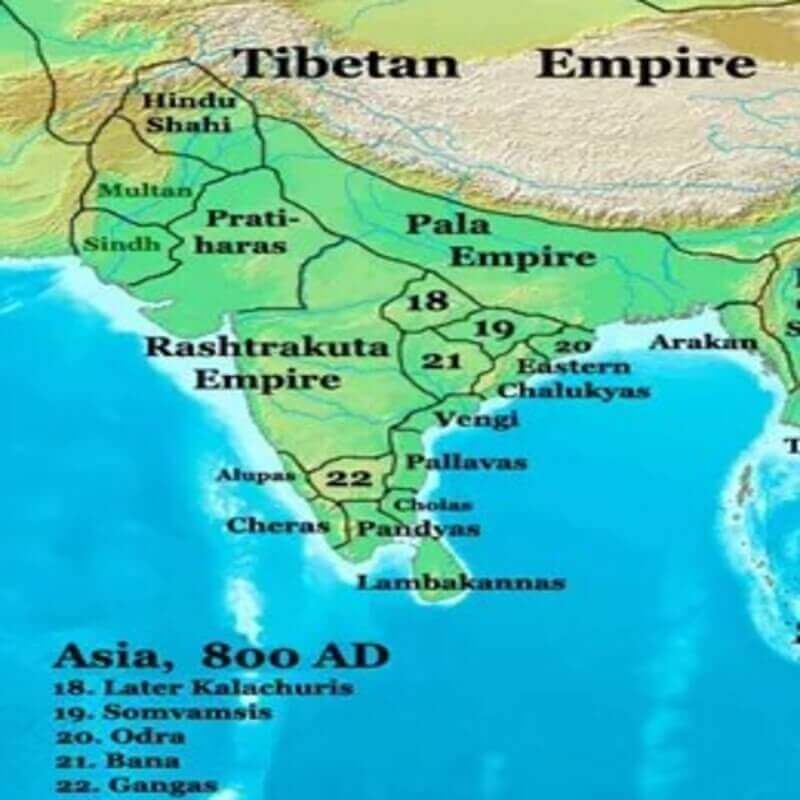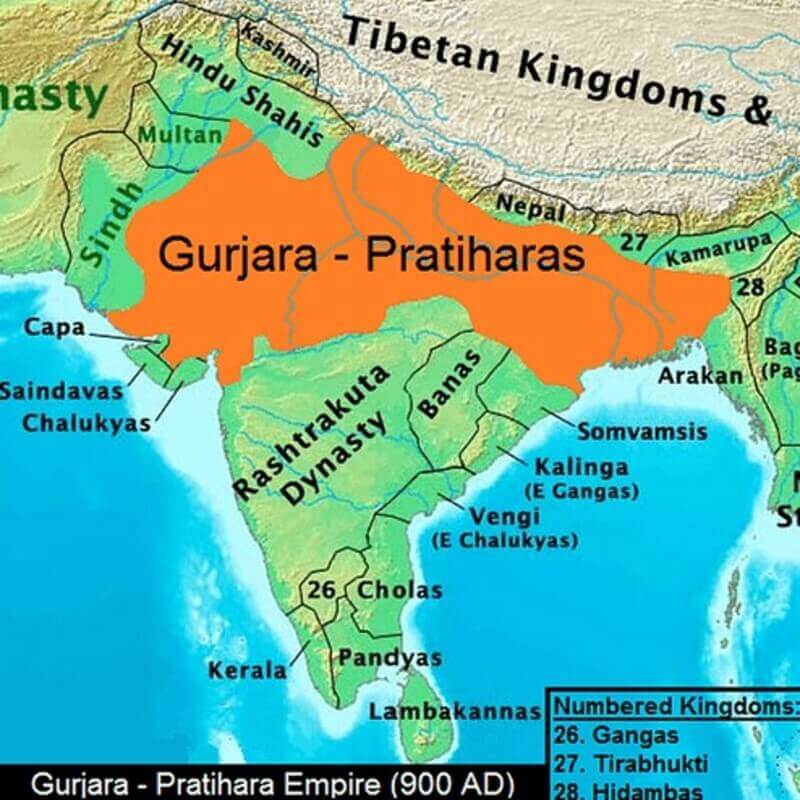
The tripartite struggle between Rashtrakutas, Palas, and Gurjara Pratiharas marks the beginning of the medieval era. We have learned about the Rashtakuats in the last article. Read here to know about the Palas and Gurjara Pratiharas.
After the death of Sashanka, the king of Gaur and Harshavardhan’s great rival around 637 CE, there was a century of anarchy and confusion in Bengal.
This situation is described by the Sanskrit phrase Matsya Nyaya (fish justice) which means a situation in which big fish prey on the smaller ones.
During this time the neighboring kingdom of Assam attacked the Bengal area taking advantage of the anarchy. At this point, all the smaller kingdoms came together and the nobles of the region elected one ruler to fill the power vacuum and protect the lands.
The Palas of Bengal

The kingdom of the Palas was founded by Gopala in 750 CE when he was elected king by nobles of the region, to fill the power vacuum.
He converted to Buddhism and was considered the first Buddhist king of Bengal.
Dharmapala (770-80 CE)
Rashtrakuta ruler Dhruva, defeated both Dharmapala of Palas and Gurjara Pratiharas.
- After the symbolic victories, Dhruva returned to Deccan which s left Kanauj unoccupied.
Dharmapala occupied Kanauj and held a grand darbar attended by vassal rulers of Punjab, eastern Rajasthan, etc.
- However, Dharmapala had to fall back after Pratihara’s power was revived under Nagabhatta II and Dharmapala was defeated near Munger.
Devpala (810-850 CE)
Devapala was the son of Dharmapala and Rannadevi, a Rashtrakuta princess. His reign saw the maximum extent of the Pala kingdom. The details of his rule are inscribed in the Munger copper Plate.
- He extended control over Pragjyotishpur (Assam) and parts of Orissa.
- Parts of modern-day Nepal also became his vassals.
- For a while, his control also extended over Benaras.
- He defeated Amoghavarsha of Rashtrakutas.
Mahendrapala (Devpala’s son) (854 – 860 CE)
- He retained control over most of Bengal but lost some territories to the Pratiharas.
- He was succeeded by his younger brother Shurapala I.
The Pala dynasty was fully replaced by the Sena dynasty in around the 12th century.
Features of the Pala dynasty
The Pala period is known as the golden period of Bengali history.
- The first Bengali literary work Charyapada is attributed to this period. It was written in an Abahatta language (the common ancestor of Bengali, Assamese, Odia, and Maithili).
- Buddhist poet Vajradatta who composed Lokesvarashataka was in Devapala’s court.
- Sanskrit scholars were also patronized by the Pala kings and Gaudapada composed Agama Shastra during this time.
- The Pala art seen in Bengal and Bihar influenced the art of Nepal, Sri Lanka, Burma, and Java.
Most of the accounts of the Pala dynasty are known from important foreign visitors’ accounts at this time, and Arab merchant, Sulaiman.
- He visited India around 850 CE, in the middle of the 9th Century.
- In his writings, the Pala kingdom is called ‘Ruhma’ (Dharma-probably denoting Dharmapala).
- He wrote that the Pala ruler had more troops than the Rashtrakutas and Pratiharas.
- He mentioned that it was customary for the Pala king to be accompanied by a force of 50,000 elephants, which shows the grandeur of the Pala forces.
Other foreign sources on the Palas are the Tibetan chronicles written by Taranath which were compiled much later in the 17th Century.
Palas had maintained close cultural relations with Tibet and introduced a new form of Buddhism there. Hence, many Tibetan Buddhists came to Nalanda and Vikramsila for studies.
The Palas were great patrons of Buddhist learning and religion.
- Nalanda University was revived by Dharmapala.
- Tax collection from about 200 villages was allocated for its maintenance.
- Dharmapala also founded the Vikramsila University in the modern-day Bhagalpur district of Bihar. It was second only to Nalanda in fame and education.
- Palas also built many viharas for monks and magnificent monasteries and temples: Somapura Mahavihara (in Bangladesh), and Odantapuri Monastery.
Palas also had trade and cultural links with South East Asia.
- The Sailendra dynasty (ruled the Srivijaya Empire of Sumatra and Medang Kingdom of Java) who followed Mahayana Buddhism, sent embassies to the Palas.
- They got permission to build a monastery at Nalanda and Devapala endowed taxes from 5 villages for the upkeep of the monastery.
The Gurjara Pratihara dynasty

They were called the Gurjara-Pratiharas because they originated from the south-western region of Rajasthan, known as Gurjaratra or Gurjaradesa.
They started as local officials, who carved out a series of district towns in central and eastern Rajasthan.
The kingdom was founded by Nagabhatta I (730-760 CE)
- The Pratiharas resisted a lot of Arab incursions from Sindh and defeated the Arabs in the battle of Rajasthan in 738 CE.
- Many times the Rashtrakuta rulers-Dhruva and Gopala III defeated the Pratihara quests to gain the upper Gangetic valley and Malwa.
Mihir Bhoja (836-885 CE) is considered as the greatest ruler of the Pratihara empire as he rebuilt the empire.
- Bhoja recovered Kanauj in 836 and it remained their capital for almost a century after that.
- Bhoja tried to expand eastwards but was defeated by Devapala.
- After the battle with the Rashtrakutas on the bank of the Narmada, Bhoja retained control over parts of Malwa and Gujarat but he was unable to proceed farther south.
- An inscription says that his territories extended to the east of the Sutlej River.
After Devapala’s death and the subsequent weakening of the Pala kingdom, Bhoja extended his empire in the east.
Bhoja was a devotee of Vishnu hence he adopted the title of ‘Adivaraha’ which is inscribed on some of his coins.
The Pratiharas had good sturdy cavalry as they imported horses from Arabia and Central Asia.
- Some Arab merchant-traveler accounts say Pratiharas had the largest cavalry in India.
Mihir Bhoja died in 885 CE and was succeeded by his son Mahendrapala I.
(**There was a Mahendrapala in Pala dynasty also who was Devpala’s son).
- Mahendrapala ruled till 908-09 and maintained the empire of Bhoja, which extended over northern Bengal.
- He lost Punjab after losing to the king of Kashmir.
- His inscriptions are found in Kathiawar, east Punjab, and Awadh.
Many foreign accounts have been found describing the Pratihara kingdom.
Al-Masudi of Baghdad visited Gujarat from 915 to 916.
- He calls the Gurjara Pratihara kingdom, Al-Juzr.
- He wrote that the kingdom has 18,00,000 villages and cities and that the king’s army had 4 divisions.
- He mentioned the wars fought by the Pratiharas, like with the ruler of Multan in the north, Rahstrakutas in the south, and Palas in the east.
The Pratiharas encouraged art and culture:
- Sanskrit poet and dramatist Rajashekhar lived at the court of Mahipala who was the grandson of Bhoja.
- Pratiharas built many fine temples in Kanauj.
- They sent Indian scholars and embassies to the Caliph of Baghdad where they introduced Indian mathematics and sciences to the Arabs which later spread to Europe through the Moors.
Administration of Gurjara Pratiharas
- Some areas of the empires were administered directly while other areas were ruled by vassal chiefs.
- Vassal chiefs were autonomous in internal affairs, however, they had to pay fixed tribute and supply troops to the Pratihara King.
- The vassal’s chiefs like Paramaras of Malwa and Chandellas of Bundelkhand rebelled whenever the Pratiharas had a weak ruler.
Palas and Gurjara Pratiharas had similar administrative division:
- Bhukti (provinces)
- Mandalas or Visayas(districts)
- Pattala was the unit below the Visaya in the Pala kingdom
The Governor of Bhukti was called ‘Uparika’ and he collected land revenue and maintained law and order with the help of the army.
The head of mandala or visaya was ‘Visayapati’ who had the same duties as uparika but on a larger area.
The village administration was carried out by the village headman and the village accountant and these posts were hereditary.
- They were paid by grants of rent-free lands.
- The headman was often helped in his duties by the village elder who was called the grama-mahajana or grama-mahattara.
The Pratiharas kingdom saw growth of small chieftains called samantas or bhogapatis who dominated over several villages.
- Visayapatis and smaller chiefs merged later and the term Samanta is later used for both.
The weakening of Gurjara Pratiharas
- During 915 – 918 CE, the Rashtrakuta king Indra III attacked Kanauj and devastated the city during the reign of Mahipala I.
- Pratiharas also lost Gujarat to the Rashtrakutas which cut off their access to the sea trade hence leading to an economic slowdown.
- Then around 963CE, Rashtrakuta ruler Krishna III invaded northern parts and defeated the Pratiharas which led to their rapid dissolution.
The later rulers could not revive the dynasty and gradually their feudatories declared independence and the empire was reduced to the area around Kannauj.
In the the11th century CE, the Ghaznavids completely wiped off the Pratiharas from the political map.
The Pratiharas were succeeded by smaller Rajput clans of Chauhans/Chahamanas (Rajputana), the Paramaras/Pawars (Malwa), and the Solankis/Chalukyas (Gujarat)
The three kingdoms – Palas, Pratiharas, and Rashtrakutas maintained a large and well-organized army consisting of infantry, cavalry, and war elephants.
- The Palas had the largest number of elephants.
- Pratiharas and Rashtrakutas had good cavalry of imported horses from Arabia and West Asia.
- There is no reference to war chariots during this period which shows that chariots were out of use by now.
- Rashtrakutas had a large number of forts that were garrisoned by special troops, with their independent commanders.
- The Palas and Rahstrakutas maintained navies too.
Out of all three kingdoms the Gurjara Pratiharas held the largest of the areas, defeating the Palas and Rashtrakutas, hence they are considered the winner of the tripartite struggle.
Trade and Commerce
The 7th to 10th centuries saw a period of stagnation/decline of trade in northern India due to:
- Decline in long-distance trade within the country because of internal conflicts and a policy of localism.
- Absence of gold and silver coins because of the collapse of the Western Roman Empire (476-554 CE), with whom India had profitable trade.
Indian merchants organized themselves into guilds.
- Manigraman and Nanadesi were the most famous guilds in South India.
Tamralipti (Tamluk, East Midnapore, West Bengal) was the chief port for sailing to Java, Sumatra, and other southeast kingdoms.






Mihirbhoja died in about 885 not in 836….. Correct it